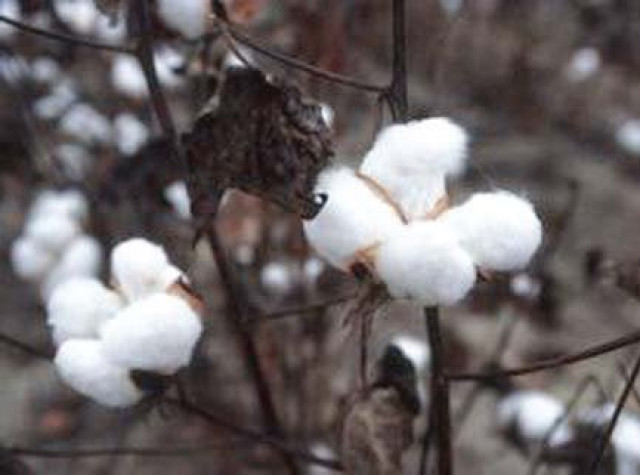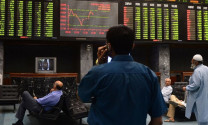Pakistan’s export performance is correlated to cotton prices – and this is a concern
This is why there is a need for value addition and diversification

This is why there is a need for value addition and diversification
PHOTO: FILE
Pakistan’s exports registered the most impressive growth in 2010-11 when they went up by 26.13% to $24.81 billion from $19.67 billion in 2009-2010. In 2010 and 2011, average world cotton prices were high, around $1.05 per pound and $1.55 per pound, respectively, compared with $0.63 per pound in 2009.
Due to high cotton prices, exports of textiles and clothing went up from $10.35 billion in 2009-10 to $13.92 billion in 2010-11, up 34.49%. In 2011-12, total and textiles and clothing export receipts fell to $23.62 billion and $12.45 billion, respectively. In 2012, world average cotton prices came down to $0.89 per pound before marginally rising to $0.90 in 2013. In 2012-13, total exports increased to $24.46 billion by 3.56%, while textiles and clothing exports registered 5.62% growth to reach $13.15 billion.
Govt agrees to stop cotton imports during crop picking
In 2017, however, cotton prices surged to $0.86 per pound, which mainly accounts for the 7.70% growth in textiles and clothing exports and 10.8% increase in overall exports in the first half of 2017-18 (July-December 2017). In December 2017, the rupee was also devalued by 5%; however, it had little to do with the export increase from July-December 2017. In the first three months of 2018, exports have continued to increase as there has been an upward movement of world cotton prices.
To give further credence to the correlation between world cotton prices and Pakistan’s export performance, it’s important to compare their movements on a calendar year basis. Pakistan’s total exports registered robust increase of 21.99% and 18.36% pc in 2010 and 2011, respectively. During those years, textiles and clothing exports also increased substantially by 20.19% (2010) and 16.97% (2011).
In 2010 and 2011, world cotton prices shot up 66.67% and 48.57%, respectively. In recent years, Pakistan’s total and textiles and clothing exports registered the steepest decline of 10.68% and 6.17% respectively in 2015, when world cotton prices fell by 15.66%. After registering negative growth in 2015 and 2016, Pakistan’s total and textiles and clothing exports went up by 9.98% and 4.03%, respectively in 2017. In that year, average world cotton prices also increased by 16.22%.
The correlation between world cotton price and Pakistan’s exports makes sense, because the country’s export basket remains largely comprised of cotton manufactures, such as home textiles, cloth and garments. Between 2009-10 and 2016-17, the T&C sector on average accounted for 55.39 pc of Pakistan’s total export earnings. After textiles and clothing sector, Pakistan’s major export is another primary commodity, rice, which accounts for nearly 9% of total export receipts. Exports of rice also depend on rice prices in international market. Like textiles and clothing exports, in recent years, rice exports registered the highest increase of 23.04% in 2010-11. After registering a decline in three consecutive years (2014-15 to 2016-17), rice exports went up by 12.48% during the first half of the current financial year mainly because of the price effect.
For two and a half decades, Pakistan’s cotton output remains virtually stagnant
Thus one of the greatest economic weaknesses of Pakistan is that it remains primarily an exporter of primary commodities, such as rice, or commodity-based manufactures, such as textiles and clothing and leather products. High value added or technology-based products, such as electrical and mechanical goods, have a very low share in the export portfolio.
The overwhelming dependence of export revenue on primary commodities entails two perils: one, the commodity prices fluctuate steeply in the international market. At times, prices change up to 50%, and even more, over a year. Two, over the long run, non-oil primary commodity prices exhibit a largely declining trend. As a result, countries like Pakistan whose export baskets consist mainly of primary commodities or manufactures derived from them experience sharp fluctuations in their export revenue from time to time.
Besides, such economies not only experience adverse terms of trade (the ratio of export to import prices); in the long-run, the terms of trade also deteriorates. The prices of goods imported by these countries, which mainly consist of finished capital and consumer goods, far exceed export prices.
For example, in 2016-17 Pakistan’s average terms of trade was 57.17% (index of average export price: 701.43, index of average import price 1226.92), while in 2005-06, the average terms of trade was 65.01%. When terms of trade are less than 100% more capital leaves the economy in the form of import payments than entering it in the form of export receipts. In order to counteract the declining price effect, a country needs to produce and export larger quantities of commodities. The problem, however, is that higher commodity supply in the international market, relative to the demand, depresses prices.
Like other countries, Pakistan’s export basket reflects its production base. As long as we remain largely a producer of primary commodities and their manufactures, we will continue to remain hostage to fluctuations in international commodity prices. While allocating scarce resources, the government’s policies, in the form of subsidies and tax exemptions, also favour the traditional sectors. It is high time to promote value added, technology-based sectors through fiscal and non-fiscal incentives.
The writer is an Islamabad-based columnist
Published in The Express Tribune, April 23rd, 2018.
Like Business on Facebook, follow @TribuneBiz on Twitter to stay informed and join in the conversation.



















COMMENTS
Comments are moderated and generally will be posted if they are on-topic and not abusive.
For more information, please see our Comments FAQ